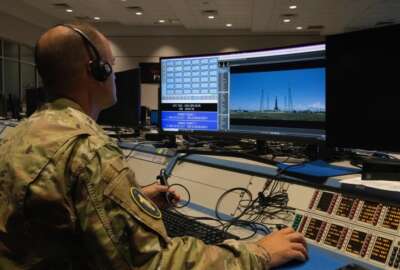

Col. Jennifer Krolikowski, the chief information officer of the Space Systems Command, said Enigma is a contractor-owned and operated integrated digital backbon...
The Space Systems Command is turning government-industry collaboration on its head.
Instead of contractors coming to government systems to share information or feedback, the Space Systems Command is testing out the opposite approach.
Col. Jennifer Krolikowski, the chief information officer of the Space Systems Command, said their new project, called Enigma, is a contractor-owned and operated integrated digital backbone to address long-time challenges to share information.

“Part of our mantra is being able to connect and work with anyone, anytime, anywhere. The concept of an Enigma then to is go from device through transport into a cloud to be able to work together, whether that’s in digital engineering or DevSecOps where we are building code or just collaborating on a document in general. Oftentimes, contractors can’t get into our networks and we can’t get into theirs, so we end up sneakernetting things or it takes forever to transport files and stuff,” Krolikowski said in an interview with Federal News Network after speaking at the Armed Forces Communications & Electronics Association (AFCEA) DC Tech Summit on April 11. “We wanted to be able to have an environment that we understood was secure, that we knew who was going to be in it, that we could actually work and do things and be more productive in that respect. One of the challenges that we always see in the current way of doing business is that a lot of those things are bifurcated. There’s a different organization that does each element of those, whether it’s device management and then all the cloud management and stuff too. So we wanted to smooth that out.”
Space Systems Command, through the Space Enterprise Consortium (SpEC), managed by National Security Technology Accelerator, awarded General Dynamics IT a one-year effort under an Other Transaction Agreement worth $18 million to create Enigma.
The accelerator said in a release from March that through the Enigma project, GDIT will create a collaborative network and a contractor operated digital environment that provides a platform-as-a-service (PaaS) capability and application on-boarding and integration support services for any government approved third-party applications from other contracts/vendors supporting operations.
Krolikowski said the effort is just getting underway, but she expects the first pilot or use case to run through the backbone in June.
“For the prototype phase, we have about a year for it to go through. I’m trying to leverage commercial as much as absolutely possible. So that’s going to help lend us to a lot of the speed that we’re looking for, to being able to deploy this kind of system,” she said. “For the prototype year, we’re really focused on the digital engineering because that’s one of the bigger pain points that we have, especially as some of our newer acquisitions are trying to hit their milestones to be able to be delivering capability.”
Krolikowski said digital engineering is moving the design and development phases to an online platform versus using pen and paper to keep track of documents and architecture drawings.
She said it promotes collaboration and sharing as well as speeds up time to deliver capabilities to the mission areas.
“I’ve got some folks who want to be able to do design reviews, who want to be able to just even understand if they change a requirement, or if they tweak something, how does that ripple through the rest of the of the design. That’s kind of the things that they can get very quickly out of using digital engineering,” Krolikowski said. “That’s really what the prototypes are focused on first. But we also have a stretch goal for DevSecOps, so that people can start building code in there, and we can have a collaborative coding environment, as well, because a lot of times, we don’t get visibility into code until after it’s been being worked for a period of time. We’re trying to get things into more an agile mindset versus some of the waterfall builds that we have today. We can do that if we are cloud based, and we both have access to the same kinds of environment.”
Space Systems Command isn’t developing Enigma in a vacuum. Krolikowski said it’s easier for her organization to try things out because of their size, but she is in touch with the Air Force CIO’s office about their progress and challenges.
“Right now for the stuff that we need to do around acquisition and to be able to get space assets on orbit before we have any challenges from some of our near peers. We needed to be able to move out much quicker than some of the things that the Air Force does,” she said. “I’m also leveraging as much as I possibly can from the Air Force. We still will tunnel back into the mothership, if you will, to be able to get those capabilities because we don’t need to manage those things. They were already being taken care of by their side.”
Copyright © 2024 Federal News Network. All rights reserved. This website is not intended for users located within the European Economic Area.
Jason Miller is executive editor of Federal News Network and directs news coverage on the people, policy and programs of the federal government.
Follow @jmillerWFED


